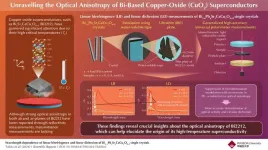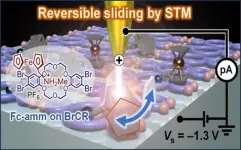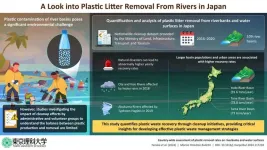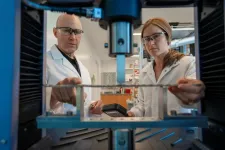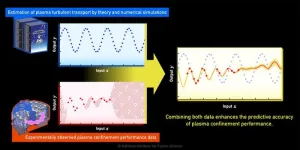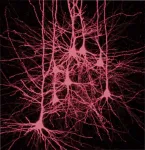(Press-News.org) The Korea Institute of Materials Science (KIMS) announced that Dr. Yong-Hun Kim from the Energy & Environment Materials Research Division and Dr. Kyung Song from the Material Characterization Center, in collaboration with Professor Hyun-Sang Hwang's team from POSTECH, have successfully developed a groundbreaking heterojunction technology. This technology integrates tungsten disulfide (WS₂), a two-dimensional (2D) material, with hafnium zirconium oxide (HZO), a ferroelectric material, achieving both interfacial stability and superior crystallinity. The results have been accepted by the International Electron Devices Meeting 2024 (IEDM 2024), one of the top three global semiconductor conferences, often referred to as the “Olympics of Semiconductors.”
Tungsten disulfide (WS₂) is a 2D material composed of tungsten and sulfur, characterized by an ultrathin atomic-layer structure. Despite its nanometer-scale thickness, it retains unique properties, making it highly suitable for applications in semiconductors and energy storage devices. Ferroelectric materials, such as HZO, exhibit spontaneous polarization even in the absence of an external electric field and are integral to non-volatile memory devices that retain information without power. Among ferroelectric materials, HZO is particularly well-known for its robust ferroelectric properties.
This study addressed the challenge of interfacial stability, a critical limitation in ferroelectric device technology, and improved the uniformity of device characteristics by controlling the crystallinity of HZO. Interfacial stability refers to the ability to minimize physical and chemical changes at the boundary between two materials, thereby maintaining the intrinsic properties of the materials over time. In semiconductor devices, higher interfacial stability directly contributes to preserving performance without degradation, which is closely tied to the overall reliability of the semiconductor.
Conventional atomic layer deposition (ALD)-based HZO deposition faces several challenges. One major issue is that during HZO deposition on the underlying electrode, exposure to high temperatures and oxygen induces unwanted chemical reactions. This results in the formation of a thin oxide layer that degrades the ferroelectric properties of HZO. Additionally, high-temperature annealing, which is essential to activate HZO's ferroelectric properties, causes oxygen atoms on the HZO thin film surface to migrate toward the electrode. This not only creates defects such as oxygen vacancies on the HZO surface but also leads to variability in ferroelectric performance across operational cycles.
To overcome these issues, it was essential to ensure the stability of the interface between the electrode and HZO. The research team addressed this by inserting a tungsten disulfide (WS₂) layer to maintain the interfacial stability between the underlying electrode and HZO. This approach minimized unwanted chemical reactions, protected the surface of the underlying electrode, and controlled the migration of oxygen atoms on the HZO thin film surface. As a result, the team successfully achieved stable interfacial properties, maximizing the ferroelectric performance of HZO.
Another major hurdle in commercializing HZO-based ferroelectrics is the disordered orientation of nanoscale domains, which leads to performance inconsistencies between devices and challenges in ensuring reliability. To address this issue, the research team leveraged the similarity between the lattice constant of tungsten disulfide (WS₂) and the interplanar spacing of specific HZO planes. This similarity allowed for excellent crystallinity when the materials were combined. By controlling the directional alignment of the material domains and maximizing their orientation uniformity, the team was able to significantly enhance the reliability of the devices.
The heterojunction technology integrating two-dimensional tungsten disulfide and HZO is considered a major technological breakthrough for developing next-generation ferroelectric-based non-volatile memory devices. Tungsten disulfide protects the underlying electrode in high-temperature environments while also promoting domain alignment, resulting in significant improvements in the performance of ferroelectric devices.
Dr. Yong-Hun Kim, the lead researcher at KIMS, stated, “We have resolved the critical challenge of controlling disordered domains, which was the biggest obstacle to commercializing HZO-based non-volatile memory devices, thereby achieving non-volatile memory characteristics with high reliability and durability.” The research team is continuing to optimize device performance under low-temperature processes (below 400°C) suitable for application in semiconductor back-end-of-line (BEOL) manufacturing.
This research was funded by the Ministry of Science and ICT, the fundamental research program of the Korea Institute of Materials Science, the Global TOP Strategy Research Group Program funded by the National Research Council of Science and Technology, and the Leading Researcher Program of the National Research Foundation of Korea. The results will be presented by Seung-Kwon Hwang, a doctoral student researcher at KIMS and the first author of the paper, at the International Electron Devices Meeting (IEDM) 2024 in San Francisco, USA, on December 11.
-----------------------------------------------------------------------
###
About Korea Institute of Materials Science(KIMS)
KIMS is a non-profit government-funded research institute under the Ministry of Science and ICT of the Republic of Korea. As the only institute specializing in comprehensive materials technologies in Korea, KIMS has contributed to Korean industry by carrying out a wide range of activities related to materials science including R&D, inspection, testing&evaluation, and technology support.
END
Semiconductor device technology recognized by the "Olympics of Semiconductors"
KIMS-POSTECH developed world’s first non-volatile memory device integrating 2D materials and ferroelectrics
2024-12-12
ELSE PRESS RELEASES FROM THIS DATE:
What brings richness to sparkling wines?
2024-12-12
“Rich” and “full-bodied” are terms that people often use to describe the taste of wine. They are also the properties that kokumi compounds bring to foods like mature Gouda cheese, though scientists haven’t widely explored them in wines. In ACS’ Journal of Agricultural and Food Chemistry, researchers now connect the dots and report 11 probable kokumi compounds in sparkling wines.
Kokumi is often confused with the better-known term umami. Umami is a savory, meaty flavor and is one of the basic five tastes, along with sweet, ...
Towards room-temperature superconductivity: Insights into optical properties of bi-based copper-oxide superconductors
2024-12-12
Superconductors are materials which conduct electricity without any resistance when cooled down below a critical temperature. These materials have transformative applications in various fields, including electric motors, generators, high-speed maglev trains, and magnetic resonance imaging. Among these materials, CuO2 superconductors like Bi2212 stand out due to their high critical temperatures that surpass the Bardeen–Cooper–Schrieffer limit, a theoretical maximum temperature limit for superconductivity. However, ...
World’s smallest molecular machine: reversible sliding motion in ammonium-linked ferrocene
2024-12-12
Artificial molecular machines, nanoscale machines consisting of a few molecules, offer the potential to transform fields involving catalysts, molecular electronics, medicines, and quantum materials. These machines operate by converting external stimuli, like electrical signals, into mechanical motion at the molecular level. Ferrocene, a special drum-shaped molecule composed of an iron (Fe) atom sandwiched between two five-membered carbon rings, is a promising foundational molecule for molecular machinery. Its discovery earned the Nobel Prize in Chemistry in 1973, and it has since ...
Researchers reveal key factors behind Japan’s plastic waste removal rates in rivers
2024-12-12
Plastic pollution is an ever-growing problem in today’s world, as most societies have become overly dependent on plastics for packaging, medical supplies, and general goods. Plastic litter accumulation in the ocean, either through deliberate dumping or by being transported from a river, poses significant environmental challenges. Additionally, this plastic eventually degrades into small fragments called microplastics, which then impact diverse marine and land ecosystems by working their way up the food chain and into most living organisms. Though their negative effects on cell health are still under study, many nations have taken a cautionary stance, ...
Implantable sensors are helping scientists improve injury recovery
2024-12-12
EUGENE, Ore. — Dec. 12, 2024 — Tiny implantable sensors are helping University of Oregon researchers optimize the process of recovery from severe bone injuries.
Scientists at the UO’s Phil and Penny Knight Campus for Accelerating Scientific Impact have developed miniature implantable sensors that transmit real-time data about what’s happening at an injury site. In a new study, they use the technology to show that a resistance-training rehabilitation program can significantly improve femur injuries in rats ...
Improved predictive accuracy of fusion plasma performance by data science
2024-12-12
Fusion energy research is being pursued around the world as a means of solving energy problems. Magnetic confinement fusion reactors aim to extract fusion energy by confining extremely hot plasma in strong magnetic fields. Its development is a comprehensive engineering project involving many advanced technologies, such as superconducting magnets, reduced-activation materials, and beam and wave heating devices. In addition, predicting and controlling the confined plasma, in which numerous charged particles and electromagnetic fields interact in complex ...
Common brain network links brain atrophy patterns seen in schizophrenia
2024-12-12
A new study led by investigators from Mass General Brigham has identified a unique brain network that links varied patterns of brain atrophy, or shrinkage, associated with schizophrenia. By combining neuroimaging data from multiple studies involving more than 8,000 participants, the research team found a specific connectivity pattern of atrophy that was present across different stages and symptoms of schizophrenia — and distinct from brain networks associated with other psychiatric disorders. The findings will help to guide a clinical trial that will start recruiting patients soon and will ...
“Us” vs. “them” biases plague AI, too
2024-12-12
Research has long shown that humans are susceptible to “social identity bias”—favoring their group, whether that be a political party, a religion, or an ethnicity, and disparaging “outgroups.” A new study by a team of scientists finds that AI systems are also prone to the same type of biases, revealing fundamental group prejudices that reach beyond those tied to gender, race, or religion.
“Artificial Intelligence systems like ChatGPT can develop ‘us versus them’ biases similar to humans—showing favoritism toward their perceived ‘ingroup’ while expressing ...
Why deep sleep is helpful for memory
2024-12-12
It has been known for nearly 20 years that slow, synchronous electrical waves in the brain during deep sleep support the formation of memories. Why that is was previously unknown. Now, writing in the journal Nature Communications, a team of researchers from Charité – Universitätsmedizin Berlin posits an explanation. According to the study, the slow waves make the neocortex, the location of long-term memory, especially receptive to information. The findings could help to optimize the treatment approaches that are intended to support memory formation from outside.
How do permanent memories form? Experts believe that while we sleep, our brains replay the events of ...
Sleepers made from recycled plastic could make railways even more eco-friendly
2024-12-12
Railways, the most climate-friendly mode of transport bar long-distance buses, are bound to play an important role in the fight for net zero. The total emissions of railway travel are currently 31 grams of CO2 equivalents (CO2e) per passenger kilometer, half the amount as for the most economical electrical vehicles.
But the carbon emissions of railway traffic can be further reduced, shows a new study in Frontiers in Sustainability by authors in Finland. This is because typical construction materials such as steel and concrete are energetically costly to produce, transport, handle, and maintain. Even on the ...
LAST 30 PRESS RELEASES:
American College of Cardiology comments on new dietary guidelines for Americans
American Society of Gene & Cell Therapy and Orphan Therapeutics Accelerator partner to advance and commercialize promising rare disease treatments
One in 14 patients having day case surgery have new or worse chronic pain 3 months after their operation
New study highlights link between eviction rates and gun violence
Heatwaves heat up soil but not toxin levels in rice, study finds
Digital modeling reveals where construction carbon emissions really come from
Turning farm waste into water filters
New study shows how the spleen helps the immune system accept a transplant
New Mayo Clinic study advances personalized prostate cancer education with an EHR-integrated AI agent
Researchers identify novel therapeutic target to improve recovery after nerve injury
Microbes in breast milk help populate infant gut microbiomes
Reprogramming immunity to rewrite the story of Type 1 diabetes
New tool narrows the search for ideal material structures
Artificial saliva containing sugarcane protein helps protect the teeth of patients with head and neck cancer
Understanding the role of linear ubiquitination in T-tubule biogenesis
Researchers identify urban atmosphere as primary reservoir of microplastics
World’s oldest arrow poison – 60,000-year-old traces reveal early advanced hunting techniques
Bristol scientists discover early sponges were soft
New study uncovers how rice viruses manipulate plant defenses to protect insect vectors
NSF–DOE Vera C. Rubin Observatory spots record-breaking asteroid in pre-survey observations
Ribosomal engineering creates “super-probiotic” bacteria
This self-powered eye tracker harnesses energy from blinking and is as comfortable as everyday glasses
Adverse prenatal exposures linked to higher rates of mental health issues, brain changes in adolescents
Restoring mitochondria shows promise for treating chronic nerve pain
Nature study identifies a molecular switch that controls transitions between single-celled and multicellular forms
USU chemists' CRISPR discovery could lead to single diagnostic test for COVID, flu, RSV
Early hominins from Morocco reveal an African lineage near the root of Homo sapiens
Small chimps, big risks: What chimps show us about our own behavior
We finally know how the most common types of planets are created
Thirty-year risk of cardiovascular disease among healthy women according to clinical thresholds of lipoprotein(a)
[Press-News.org] Semiconductor device technology recognized by the "Olympics of Semiconductors"KIMS-POSTECH developed world’s first non-volatile memory device integrating 2D materials and ferroelectrics
